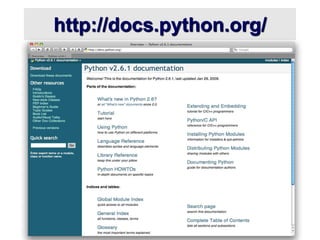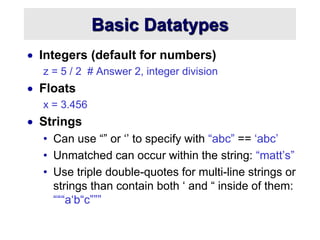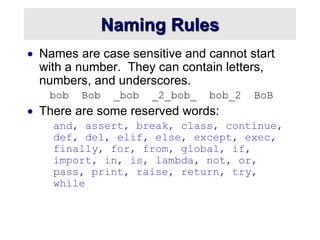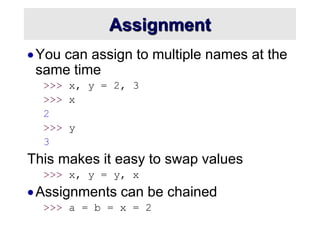Lenguaje Python
- 1. Learn Python in three hours Some material adapted from Upenn cmpe391 slides and other sources
- 2. Overview History Installing & Running Python Names & Assignment Sequences types: Lists, Tuples, and Strings Mutability
- 3. Brief History of Python Invented in the Netherlands, early 90s by Guido van Rossum Named after Monty Python Open sourced from the beginning Considered a scripting language, but is much more Scalable, object oriented and functional from the beginning Used by Google from the beginning Increasingly popular
- 4. Python’s Benevolent Dictator For Life “Python is an experiment in how much freedom program- mers need. Too much freedom and nobody can read another's code; too little and expressive- ness is endangered.” - Guido van Rossum
- 6. The Python tutorial is good!
- 8. The Python Interpreter Typical Python implementations offer both an interpreter and compiler Interactive interface to Python with a read-eval-print loop [finin@linux2 ~]$ python Python 2.4.3 (#1, Jan 14 2008, 18:32:40) [GCC 4.1.2 20070626 (Red Hat 4.1.2-14)] on linux2 Type "help", "copyright", "credits" or "license" for more information. >>> def square(x): ... return x * x ... >>> map(square, [1, 2, 3, 4]) [1, 4, 9, 16] >>>
- 9. Installing Python is pre-installed on most Unix systems, including Linux and MAC OS X The pre-installed version may not be the most recent one (2.6.2 and 3.1.1 as of Sept 09) Download from http://python.org/download/ Python comes with a large library of standard modules There are several options for an IDE • IDLE – works well with Windows • Emacs with python-mode or your favorite text editor • Eclipse with Pydev (http://pydev.sourceforge.net/)
- 10. IDLE Development Environment IDLE is an Integrated DeveLopment Environ- ment for Python, typically used on Windows Multi-window text editor with syntax highlighting, auto-completion, smart indent and other. Python shell with syntax highlighting. Integrated debugger with stepping, persis- tent breakpoints, and call stack visi- bility
- 11. Editing Python in Emacs Emacs python-mode has good support for editing Python, enabled enabled by default for .py files Features: completion, symbol help, eldoc, and inferior interpreter shell, etc.
- 12. Running Interactively on UNIX On Unix… % python >>> 3+3 6 Python prompts with ‘>>>’. To exit Python (not Idle): • In Unix, type CONTROL-D • In Windows, type CONTROL-Z + <Enter> • Evaluate exit()
- 13. Running Programs on UNIX Call python program via the python interpreter % python fact.py Make a python file directly executable by • Adding the appropriate path to your python interpreter as the first line of your file #!/usr/bin/python • Making the file executable % chmod a+x fact.py • Invoking file from Unix command line % fact.py
- 14. Example ‘script’: fact.py #! /usr/bin/python def fact(x): """Returns the factorial of its argument, assumed to be a posint""" if x == 0: return 1 return x * fact(x - 1) print print ’N fact(N)’ print "---------" for n in range(10): print n, fact(n)
- 15. Python Scripts When you call a python program from the command line the interpreter evaluates each expression in the file Familiar mechanisms are used to provide command line arguments and/or redirect input and output Python also has mechanisms to allow a python program to act both as a script and as a module to be imported and used by another python program
- 16. Example of a Script #! /usr/bin/python """ reads text from standard input and outputs any email addresses it finds, one to a line. """ import re from sys import stdin # a regular expression ~ for a valid email address pat = re.compile(r'[-w][-.w]*@[-w][-w.]+[a-zA-Z]{2,4}') for line in stdin.readlines(): for address in pat.findall(line): print address
- 17. results python> python email0.py <email.txt [email protected] [email protected] [email protected] [email protected] python>
- 18. Getting a unique, sorted list import re from sys import stdin pat = re.compile(r'[-w][-.w]*@[-w][-w.]+[a-zA-Z]{2,4}’) # found is an initially empty set (a list w/o duplicates) found = set( ) for line in stdin.readlines(): for address in pat.findall(line): found.add(address) # sorted() takes a sequence, returns a sorted list of its elements for address in sorted(found): print address
- 19. results python> python email2.py <email.txt [email protected] [email protected] [email protected] python>
- 20. Simple functions: ex.py """factorial done recursively and iteratively""" def fact1(n): ans = 1 for i in range(2,n): ans = ans * n return ans def fact2(n): if n < 1: return 1 else: return n * fact2(n - 1)
- 21. Simple functions: ex.py 671> python Python 2.5.2 … >>> import ex >>> ex.fact1(6) 1296 >>> ex.fact2(200) 78865786736479050355236321393218507…000000L >>> ex.fact1 <function fact1 at 0x902470> >>> fact1 Traceback (most recent call last): File "<stdin>", line 1, in <module> NameError: name 'fact1' is not defined >>>
- 22. The Basics
- 23. A Code Sample (in IDLE) x = 34 - 23 # A comment. y = “Hello” # Another one. z = 3.45 if z == 3.45 or y == “Hello”: x = x + 1 y = y + “ World” # String concat. print x print y
- 24. Enough to Understand the Code Indentation matters to code meaning • Block structure indicated by indentation First assignment to a variable creates it • Variable types don’t need to be declared. • Python figures out the variable types on its own. Assignment is = and comparison is == For numbers + - * / % are as expected • Special use of + for string concatenation and % for string formatting (as in C’s printf) Logical operators are words (and, or, not) not symbols The basic printing command is print
- 25. Basic Datatypes Integers (default for numbers) z = 5 / 2 # Answer 2, integer division Floats x = 3.456 Strings • Can use “” or ‘’ to specify with “abc” == ‘abc’ • Unmatched can occur within the string: “matt’s” • Use triple double-quotes for multi-line strings or strings than contain both ‘ and “ inside of them: “““a‘b“c”””
- 26. Whitespace Whitespace is meaningful in Python: especially indentation and placement of newlines Use a newline to end a line of code Use when must go to next line prematurely No braces {} to mark blocks of code, use consistent indentation instead • First line with less indentation is outside of the block • First line with more indentation starts a nested block Colons start of a new block in many constructs, e.g. function definitions, then clauses
- 27. Comments Start comments with #, rest of line is ignored Can include a “documentation string” as the first line of a new function or class you define Development environments, debugger, and other tools use it: it’s good style to include one def fact(n): “““fact(n) assumes n is a positive integer and returns facorial of n.””” assert(n>0) return 1 if n==1 else n*fact(n-1)
- 28. Assignment Binding a variable in Python means setting a name to hold a reference to some object • Assignment creates references, not copies Names in Python do not have an intrinsic type, objects have types • Python determines the type of the reference automatically based on what data is assigned to it You create a name the first time it appears on the left side of an assignment expression: x = 3 A reference is deleted via garbage collection after any names bound to it have passed out of scope Python uses reference semantics (more later)
- 29. Naming Rules Names are case sensitive and cannot start with a number. They can contain letters, numbers, and underscores. bob Bob _bob _2_bob_ bob_2 BoB There are some reserved words: and, assert, break, class, continue, def, del, elif, else, except, exec, finally, for, from, global, if, import, in, is, lambda, not, or, pass, print, raise, return, try, while
- 30. Naming conventions The Python community has these recommend- ed naming conventions joined_lower for functions, methods and, attributes joined_lower or ALL_CAPS for constants StudlyCaps for classes camelCase only to conform to pre-existing conventions Attributes: interface, _internal, __private
- 31. Assignment You can assign to multiple names at the same time >>> x, y = 2, 3 >>> x 2 >>> y 3 This makes it easy to swap values >>> x, y = y, x Assignments can be chained >>> a = b = x = 2
- 32. Accessing Non-Existent Name Accessing a name before it’s been properly created (by placing it on the left side of an assignment), raises an error >>> y Traceback (most recent call last): File "<pyshell#16>", line 1, in -toplevel- y NameError: name ‘y' is not defined >>> y = 3 >>> y 3
- 33. Sequence types: Tuples, Lists, and Strings
- 34. Sequence Types 1. Tuple: (‘john’, 32, [CMSC]) A simple immutable ordered sequence of items Items can be of mixed types, including collection types 2. Strings: “John Smith” • Immutable • Conceptually very much like a tuple 3. List: [1, 2, ‘john’, (‘up’, ‘down’)] Mutable ordered sequence of items of mixed types
- 35. Similar Syntax All three sequence types (tuples, strings, and lists) share much of the same syntax and functionality. Key difference: • Tuples and strings are immutable • Lists are mutable The operations shown in this section can be applied to all sequence types • most examples will just show the operation performed on one
- 36. Sequence Types 1 Define tuples using parentheses and commas >>> tu = (23, ‘abc’, 4.56, (2,3), ‘def’) Define lists are using square brackets and commas >>> li = [“abc”, 34, 4.34, 23] Define strings using quotes (“, ‘, or “““). >>> st = “Hello World” >>> st = ‘Hello World’ >>> st = “““This is a multi-line string that uses triple quotes.”””
- 37. Sequence Types 2 Access individual members of a tuple, list, or string using square bracket “array” notation Note that all are 0 based… >>> tu = (23, ‘abc’, 4.56, (2,3), ‘def’) >>> tu[1] # Second item in the tuple. ‘abc’ >>> li = [“abc”, 34, 4.34, 23] >>> li[1] # Second item in the list. 34 >>> st = “Hello World” >>> st[1] # Second character in string. ‘e’
- 38. Positive and negative indices >>> t = (23, ‘abc’, 4.56, (2,3), ‘def’) Positive index: count from the left, starting with 0 >>> t[1] ‘abc’ Negative index: count from right, starting with –1 >>> t[-3] 4.56
- 39. Slicing: return copy of a subset >>> t = (23, ‘abc’, 4.56, (2,3), ‘def’) Return a copy of the container with a subset of the original members. Start copying at the first index, and stop copying before second. >>> t[1:4] (‘abc’, 4.56, (2,3)) Negative indices count from end >>> t[1:-1] (‘abc’, 4.56, (2,3))
- 40. Slicing: return copy of a =subset >>> t = (23, ‘abc’, 4.56, (2,3), ‘def’) Omit first index to make copy starting from beginning of the container >>> t[:2] (23, ‘abc’) Omit second index to make copy starting at first index and going to end >>> t[2:] (4.56, (2,3), ‘def’)
- 41. Copying the Whole Sequence [ : ] makes a copy of an entire sequence >>> t[:] (23, ‘abc’, 4.56, (2,3), ‘def’) Note the difference between these two lines for mutable sequences >>> l2 = l1 # Both refer to 1 ref, # changing one affects both >>> l2 = l1[:] # Independent copies, two refs
- 42. The ‘in’ Operator Boolean test whether a value is inside a container: >>> t = [1, 2, 4, 5] >>> 3 in t False >>> 4 in t True >>> 4 not in t False For strings, tests for substrings >>> a = 'abcde' >>> 'c' in a True >>> 'cd' in a True >>> 'ac' in a False Be careful: the in keyword is also used in the syntax of for loops and list comprehensions
- 43. The + Operator The + operator produces a new tuple, list, or string whose value is the concatenation of its arguments. >>> (1, 2, 3) + (4, 5, 6) (1, 2, 3, 4, 5, 6) >>> [1, 2, 3] + [4, 5, 6] [1, 2, 3, 4, 5, 6] >>> “Hello” + “ ” + “World” ‘Hello World’
- 44. The * Operator The * operator produces a new tuple, list, or string that “repeats” the original content. >>> (1, 2, 3) * 3 (1, 2, 3, 1, 2, 3, 1, 2, 3) >>> [1, 2, 3] * 3 [1, 2, 3, 1, 2, 3, 1, 2, 3] >>> “Hello” * 3 ‘HelloHelloHello’
- 46. Lists are mutable >>> li = [‘abc’, 23, 4.34, 23] >>> li[1] = 45 >>> li [‘abc’, 45, 4.34, 23] We can change lists in place. Name li still points to the same memory reference when we’re done.
- 47. Tuples are immutable >>> t = (23, ‘abc’, 4.56, (2,3), ‘def’) >>> t[2] = 3.14 Traceback (most recent call last): File "<pyshell#75>", line 1, in -toplevel- tu[2] = 3.14 TypeError: object doesn't support item assignment You can’t change a tuple. You can make a fresh tuple and assign its reference to a previously used name. >>> t = (23, ‘abc’, 3.14, (2,3), ‘def’) The immutability of tuples means they’re faster than lists.
- 48. Operations on Lists Only >>> li = [1, 11, 3, 4, 5] >>> li.append(‘a’) # Note the method syntax >>> li [1, 11, 3, 4, 5, ‘a’] >>> li.insert(2, ‘i’) >>>li [1, 11, ‘i’, 3, 4, 5, ‘a’]
- 49. The extend method vs + + creates a fresh list with a new memory ref extend operates on list li in place. >>> li.extend([9, 8, 7]) >>> li [1, 2, ‘i’, 3, 4, 5, ‘a’, 9, 8, 7] Potentially confusing: • extend takes a list as an argument. • append takes a singleton as an argument. >>> li.append([10, 11, 12]) >>> li [1, 2, ‘i’, 3, 4, 5, ‘a’, 9, 8, 7, [10, 11, 12]]
- 50. Operations on Lists Only Lists have many methods, including index, count, remove, reverse, sort >>> li = [‘a’, ‘b’, ‘c’, ‘b’] >>> li.index(‘b’) # index of 1st occurrence 1 >>> li.count(‘b’) # number of occurrences 2 >>> li.remove(‘b’) # remove 1st occurrence >>> li [‘a’, ‘c’, ‘b’]
- 51. Operations on Lists Only >>> li = [5, 2, 6, 8] >>> li.reverse() # reverse the list *in place* >>> li [8, 6, 2, 5] >>> li.sort() # sort the list *in place* >>> li [2, 5, 6, 8] >>> li.sort(some_function) # sort in place using user-defined comparison
- 52. Tuple details The comma is the tuple creation operator, not parens >>> 1, (1,) Python shows parens for clarity (best practice) >>> (1,) (1,) Don't forget the comma! >>> (1) 1 Trailing comma only required for singletons others Empty tuples have a special syntactic form >>> () () >>> tuple() ()
- 53. Summary: Tuples vs. Lists Lists slower but more powerful than tuples • Lists can be modified, and they have lots of handy operations and mehtods • Tuples are immutable and have fewer features To convert between tuples and lists use the list() and tuple() functions: li = list(tu) tu = tuple(li)







![The Python Interpreter
Typical Python implementations offer
both an interpreter and compiler
Interactive interface to Python with a
read-eval-print loop
[finin@linux2 ~]$ python
Python 2.4.3 (#1, Jan 14 2008, 18:32:40)
[GCC 4.1.2 20070626 (Red Hat 4.1.2-14)] on linux2
Type "help", "copyright", "credits" or "license" for more information.
>>> def square(x):
... return x * x
...
>>> map(square, [1, 2, 3, 4])
[1, 4, 9, 16]
>>>](https://image.slidesharecdn.com/python1-231018145027-8c59c7ce/85/Lenguaje-Python-8-320.jpg)







![Example of a Script
#! /usr/bin/python
""" reads text from standard input and outputs any email
addresses it finds, one to a line.
"""
import re
from sys import stdin
# a regular expression ~ for a valid email address
pat = re.compile(r'[-w][-.w]*@[-w][-w.]+[a-zA-Z]{2,4}')
for line in stdin.readlines():
for address in pat.findall(line):
print address](https://image.slidesharecdn.com/python1-231018145027-8c59c7ce/85/Lenguaje-Python-16-320.jpg)

![Getting a unique, sorted list
import re
from sys import stdin
pat = re.compile(r'[-w][-.w]*@[-w][-w.]+[a-zA-Z]{2,4}’)
# found is an initially empty set (a list w/o duplicates)
found = set( )
for line in stdin.readlines():
for address in pat.findall(line):
found.add(address)
# sorted() takes a sequence, returns a sorted list of its elements
for address in sorted(found):
print address](https://image.slidesharecdn.com/python1-231018145027-8c59c7ce/85/Lenguaje-Python-18-320.jpg)















![Sequence Types
1. Tuple: (‘john’, 32, [CMSC])
A simple immutable ordered sequence of
items
Items can be of mixed types, including
collection types
2. Strings: “John Smith”
• Immutable
• Conceptually very much like a tuple
3. List: [1, 2, ‘john’, (‘up’, ‘down’)]
Mutable ordered sequence of items of
mixed types](https://image.slidesharecdn.com/python1-231018145027-8c59c7ce/85/Lenguaje-Python-34-320.jpg)

![Sequence Types 1
Define tuples using parentheses and commas
>>> tu = (23, ‘abc’, 4.56, (2,3), ‘def’)
Define lists are using square brackets and
commas
>>> li = [“abc”, 34, 4.34, 23]
Define strings using quotes (“, ‘, or “““).
>>> st = “Hello World”
>>> st = ‘Hello World’
>>> st = “““This is a multi-line
string that uses triple quotes.”””](https://image.slidesharecdn.com/python1-231018145027-8c59c7ce/85/Lenguaje-Python-36-320.jpg)
![Sequence Types 2
Access individual members of a tuple, list, or
string using square bracket “array” notation
Note that all are 0 based…
>>> tu = (23, ‘abc’, 4.56, (2,3), ‘def’)
>>> tu[1] # Second item in the tuple.
‘abc’
>>> li = [“abc”, 34, 4.34, 23]
>>> li[1] # Second item in the list.
34
>>> st = “Hello World”
>>> st[1] # Second character in string.
‘e’](https://image.slidesharecdn.com/python1-231018145027-8c59c7ce/85/Lenguaje-Python-37-320.jpg)
![Positive and negative indices
>>> t = (23, ‘abc’, 4.56, (2,3), ‘def’)
Positive index: count from the left, starting with 0
>>> t[1]
‘abc’
Negative index: count from right, starting with –1
>>> t[-3]
4.56](https://image.slidesharecdn.com/python1-231018145027-8c59c7ce/85/Lenguaje-Python-38-320.jpg)
![Slicing: return copy of a subset
>>> t = (23, ‘abc’, 4.56, (2,3), ‘def’)
Return a copy of the container with a subset of
the original members. Start copying at the first
index, and stop copying before second.
>>> t[1:4]
(‘abc’, 4.56, (2,3))
Negative indices count from end
>>> t[1:-1]
(‘abc’, 4.56, (2,3))](https://image.slidesharecdn.com/python1-231018145027-8c59c7ce/85/Lenguaje-Python-39-320.jpg)
![Slicing: return copy of a =subset
>>> t = (23, ‘abc’, 4.56, (2,3), ‘def’)
Omit first index to make copy starting from
beginning of the container
>>> t[:2]
(23, ‘abc’)
Omit second index to make copy starting at first
index and going to end
>>> t[2:]
(4.56, (2,3), ‘def’)](https://image.slidesharecdn.com/python1-231018145027-8c59c7ce/85/Lenguaje-Python-40-320.jpg)
![Copying the Whole Sequence
[ : ] makes a copy of an entire sequence
>>> t[:]
(23, ‘abc’, 4.56, (2,3), ‘def’)
Note the difference between these two lines
for mutable sequences
>>> l2 = l1 # Both refer to 1 ref,
# changing one affects both
>>> l2 = l1[:] # Independent copies, two
refs](https://image.slidesharecdn.com/python1-231018145027-8c59c7ce/85/Lenguaje-Python-41-320.jpg)
![The ‘in’ Operator
Boolean test whether a value is inside a container:
>>> t = [1, 2, 4, 5]
>>> 3 in t
False
>>> 4 in t
True
>>> 4 not in t
False
For strings, tests for substrings
>>> a = 'abcde'
>>> 'c' in a
True
>>> 'cd' in a
True
>>> 'ac' in a
False
Be careful: the in keyword is also used in the syntax
of for loops and list comprehensions](https://image.slidesharecdn.com/python1-231018145027-8c59c7ce/85/Lenguaje-Python-42-320.jpg)
![The + Operator
The + operator produces a new tuple, list, or
string whose value is the concatenation of its
arguments.
>>> (1, 2, 3) + (4, 5, 6)
(1, 2, 3, 4, 5, 6)
>>> [1, 2, 3] + [4, 5, 6]
[1, 2, 3, 4, 5, 6]
>>> “Hello” + “ ” + “World”
‘Hello World’](https://image.slidesharecdn.com/python1-231018145027-8c59c7ce/85/Lenguaje-Python-43-320.jpg)
![The * Operator
The * operator produces a new tuple, list, or
string that “repeats” the original content.
>>> (1, 2, 3) * 3
(1, 2, 3, 1, 2, 3, 1, 2, 3)
>>> [1, 2, 3] * 3
[1, 2, 3, 1, 2, 3, 1, 2, 3]
>>> “Hello” * 3
‘HelloHelloHello’](https://image.slidesharecdn.com/python1-231018145027-8c59c7ce/85/Lenguaje-Python-44-320.jpg)

![Lists are mutable
>>> li = [‘abc’, 23, 4.34, 23]
>>> li[1] = 45
>>> li
[‘abc’, 45, 4.34, 23]
We can change lists in place.
Name li still points to the same memory
reference when we’re done.](https://image.slidesharecdn.com/python1-231018145027-8c59c7ce/85/Lenguaje-Python-46-320.jpg)
![Tuples are immutable
>>> t = (23, ‘abc’, 4.56, (2,3), ‘def’)
>>> t[2] = 3.14
Traceback (most recent call last):
File "<pyshell#75>", line 1, in -toplevel-
tu[2] = 3.14
TypeError: object doesn't support item assignment
You can’t change a tuple.
You can make a fresh tuple and assign its
reference to a previously used name.
>>> t = (23, ‘abc’, 3.14, (2,3), ‘def’)
The immutability of tuples means they’re faster
than lists.](https://image.slidesharecdn.com/python1-231018145027-8c59c7ce/85/Lenguaje-Python-47-320.jpg)
![Operations on Lists Only
>>> li = [1, 11, 3, 4, 5]
>>> li.append(‘a’) # Note the method
syntax
>>> li
[1, 11, 3, 4, 5, ‘a’]
>>> li.insert(2, ‘i’)
>>>li
[1, 11, ‘i’, 3, 4, 5, ‘a’]](https://image.slidesharecdn.com/python1-231018145027-8c59c7ce/85/Lenguaje-Python-48-320.jpg)
![The extend method vs +
+ creates a fresh list with a new memory ref
extend operates on list li in place.
>>> li.extend([9, 8, 7])
>>> li
[1, 2, ‘i’, 3, 4, 5, ‘a’, 9, 8, 7]
Potentially confusing:
• extend takes a list as an argument.
• append takes a singleton as an argument.
>>> li.append([10, 11, 12])
>>> li
[1, 2, ‘i’, 3, 4, 5, ‘a’, 9, 8, 7, [10,
11, 12]]](https://image.slidesharecdn.com/python1-231018145027-8c59c7ce/85/Lenguaje-Python-49-320.jpg)
![Operations on Lists Only
Lists have many methods, including index, count,
remove, reverse, sort
>>> li = [‘a’, ‘b’, ‘c’, ‘b’]
>>> li.index(‘b’) # index of 1st occurrence
1
>>> li.count(‘b’) # number of occurrences
2
>>> li.remove(‘b’) # remove 1st occurrence
>>> li
[‘a’, ‘c’, ‘b’]](https://image.slidesharecdn.com/python1-231018145027-8c59c7ce/85/Lenguaje-Python-50-320.jpg)
![Operations on Lists Only
>>> li = [5, 2, 6, 8]
>>> li.reverse() # reverse the list *in place*
>>> li
[8, 6, 2, 5]
>>> li.sort() # sort the list *in place*
>>> li
[2, 5, 6, 8]
>>> li.sort(some_function)
# sort in place using user-defined comparison](https://image.slidesharecdn.com/python1-231018145027-8c59c7ce/85/Lenguaje-Python-51-320.jpg)

